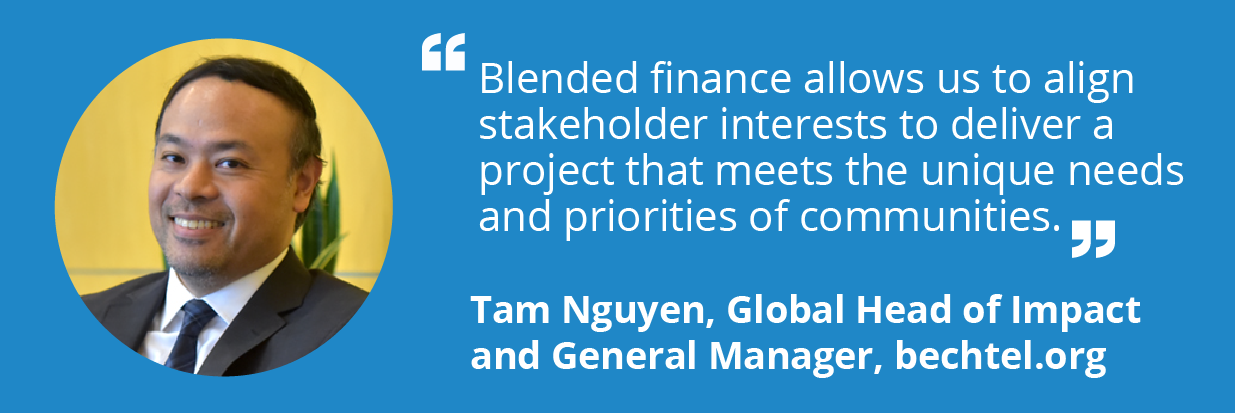Established in 1898, Bechtel is a global engineering, procurement, construction, and project management company. Bechtel has helped customers complete more than 25,000 projects in 160 countries on all seven continents.
Housed within Bechtel Infrastructure, bechtel.org is the corporation’s social enterprise. Structured as a breakeven business, their mission is to help build resilient and sustainable communities in frontier and emerging markets through technical advisory and project management. bechtel.org originates its own projects, partnerships, and financing and measures impact. Their focus is execution and delivery; however, they have also been involved in project development.
Tell us about the interaction between Bechtel and bechtel.org?
bechtel.org was formed as a part of Bechtel’s sustainability journey. While exploring ways to leverage Bechtel’s core capabilities to support underserved communities in developing countries, we tested the concept with various friends in the non-profit sector and launched the Building Resilient Communities corporate initiative. We deployed technical experts into projects in Kenya, Nigeria, Philippines, and Peru and found our expertise in helping local teams manage and deliver projects was a demand driver. We also sought feedback from other corporate social enterprises and found Bechtel’s global reach and depth of experience was a key value proposition. Hence, we kept the Bechtel name and simply added .org instead of creating a separate organization with a new name. This early work informed our executive leadership and shaped bechtel.org’s business model and impact framework, which is distinct from Bechtel Foundation, Bechtel’s CSR initiatives, and Bechtel’s Sustainability and ESG.
Our integration and interaction with Bechtel Corporation is intentional and synergistic. We’re governed by a Board of advisors, an Impact Committee that assesses and evaluates our projects, and an executive sponsor that keeps us connected to the broader enterprise. We are challenged by our Board to demonstrate why this project and what impact we leave behind. We apply Bechtel’s business process and procedures to develop and deliver projects. And while we leverage Bechtel’s global resources, we do not use bechtel.org to bring commercial advantage to Bechtel. Once there’s a project scope and financing, we recruit and onboard talent from Bechtel’s global projects into bechtel.org (we do not outsource) and then integrate them into local implementing organizations. We benefit from accessing a global pool of Bechtel colleagues with a diverse set of experiences, competencies, and skills. This means we can form integrated teams that can transfer Bechtel’s knowledge and technical know-how to local organizations so they can build their own capacities to deliver projects.
We’re also sector agnostic. For example, if logistics or infrastructure (e.g., storage and process facilities) is part of a solution to boost food security in the agriculture sector, we’ll get involved. We’ll collaborate with any organization – non-profit, for-profit, government – that share our values and interests and complement our capabilities.
Increasingly, we see this synergistic integration with Bechtel Corporation as a value proposition for blended finance and impact investors as we can help de-risk investments to local firms, improve their project’s certainty of outcome, and help ensure the additionality of social impact is delivered.
What is your approach to impact infrastructure? How does blended finance support this?
For bechtel.org, the infrastructure’s value to the community is not the asset itself but the services it provides and the additionality it creates – that’s impact infrastructure. We focus on the overlooked elements like operations and maintenance (O&M), which, if neglected or addressed downstream in the project, put the intended impact at risk. For example, if the aim is to expand access to healthcare for women by solarizing health facilities in rural communities, and then a technical component of the solar energy system fails in a year because there is no O&M or sustainable financing, there’s no impact.
Issues arising from O&M or the lack of an enabling environment to sustain a project mean we spend a lot of time on engaging and supporting the ecosystem of local actors who have a stake in the durability of the project. This is very time-consuming and often requires bechtel.org becoming political athletes, but it’s important and necessary if we are focusing on the long-term.
We also measure. We want to demonstrate the correlation between infrastructure and social impact. Because we could not find an external framework that was fit for purpose, we developed our own and are road-testing it on our projects. Our intent is to build a body of knowledge and share how we’re measuring infrastructure with a community of interest. We have a full-time impact analyst devoted to this.
These experiences have been part of an ongoing rethinking and reorientation of bechtel.org and blended finance is a key part of this evolution. Catalytic capital and long-term investment from a mix of partners (e.g., foundations, banks, DFIs, aid agencies, communities, corporates) is critical to covering the costs associated with project development, capital expenditures, operating expenses, and ensuring impact. Blended finance structures discipline partners to focus on the durability of the project to achieve the intended impact.
What are the advantages of leveraging a blended finance approach? Can you give us some examples of specific transactions that illustrate this?
Blended finance helps bechtel.org in two ways:
One of the strategic pivots we’re taking is to become technical assistance facilities or accelerators to blended finance or impact funds that want to de-risk their investments, build local capacity, and deliver impact. In addition to our technical expertise in project delivery, we bring a ready-made facility with a structure, governance, and transaction model that can bolt onto these funds. This blended approach offers several advantages: risk mitigation, access to capital, mobilizing private investment, and additionality. We’re currently working with a financial intermediary to develop a climate adaptation fund and accelerator targeting Southeast Asia. We hope to replicate this for Africa and Latin America. Blended finance allows us to align stakeholder interests to deliver a project that meets the unique needs and priorities of communities. We can solve complex problems from a position of strength and often that strength is the partnership.
Second, a few of our current projects uses a pilot-test-scale approach. Blended finance plays an important role particularly in seed funding, de-risking, capacity building, and demonstration effect. In Peru, seed capital from mining companies enabled us to pilot an innovative thermal harvesting system that can futureproof thousands of indigenous homes in the remote Peruvian Andes from extreme frost. In India, seed capital from an insurance company facilitated an early assessment of a nature-based solution that regenerates polluted canals for productive use and flood mitigation. In Zambia, catalytic capital from a public aid agency enabled us to pilot a project to increase transactions between smallholder farmers and commodity buyers to reduce post-harvest loss and bolster food security. Blended finance allows us to align incentives and explore innovative financing structures to scale these projects.
How does bechtel.org apply a gender lens to its blended finance transactions?
In all our projects, we measure specific metrics around access to services (e.g., health, education, jobs) that contribute to impact on women and other marginalized demographics (e.g., migrants, youths). For example, we are developing an accelerator targeting Ukraine migrant-owned/operated SMEs and developed a vulnerability lens to identify and assess women-led SMEs that can be suppliers or service providers for energy transition projects in Europe and/or Ukraine’s future reconstruction.
Women are also part of the design thinking process for our current projects. In Peru, the thermal harvesting system mentioned earlier was based on the input of women as to what is a living temperature inside the home when temperatures drop below -10 degrees Celsius at night. Similarly in India, women were among the 350 consultations to help us identify the appropriate technology for a nature-based infrastructure solution. Our approach is to be intentional and upstream on the inclusion of women as part of the solution.
Have you faced any interesting or unexpected challenges in your blended finance journey?
Blended finance has many positives for bechtel.org. With multiple partners the amount of time to align interests and the due diligence required on each of the investors was somewhat unexpected. Despite these time challenges it's the right thing to do. I also did not expect to spend a year studying blended finance models. We knew the market was moving in this direction and it was critical to learn how it works and more importantly how we fit. It was one of the reasons we became a member of Convergence.
What are some lessons you have learned so far about measuring the impact and evaluating the success of blended finance transactions?
We’ve learned that because of our business model and the nature of our projects, bechtel.org may never participate on a project long enough to contribute to its full impact, but we can be there long enough to position the project to achieve it. We also learned that we need to measure attribution and contribution separately. Our measurement framework is implemented in two parts: attribution to bechtel.org and the project’s overall contribution to impact. By separating the two we can distinguish between the level of control we have on the project and, alongside with our partners, capture the project’s overall contribution to impact.
What have the different types of stakeholders that you’ve worked with looked for in blended finance deals?
Our stakeholders have diverse objectives, preferences, and expectations. In our projects, public sector investors are focused on policy alignment and impact measurement while private investors prioritize financial returns and risk mitigation. Philanthropic organizations tend to emphasize innovation, scalability, and partnerships while DFIs are interested in alignment with their development mandate and crowding-in private capital. I would say all of them support blended finance deals that increase local capacity building and technical assistance.
How do you see bechtel.org’s blended finance activities evolving in the future? What is next for the organization?
As I highlighted earlier, we’re positioning bechtel.org to be a technical assistance facility or accelerator to blended finance or impact investment funds. For us these financing models generate the kind of scale, durability, and impact that Bechtel is known for.

